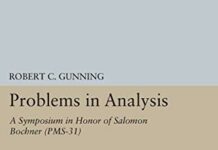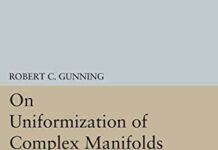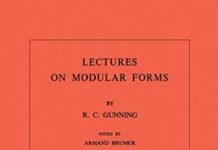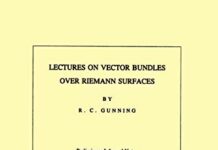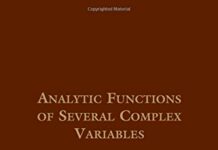
Ebook Info
- Published: 2020
- Number of pages: 246 pages
- Format: PDF
- File Size: 2.33 MB
- Authors: Robert C. Gunning
Description
The description for this book, Lectures on Vector Bundles over Riemann Surfaces. (MN-6), Volume 6, will be forthcoming.
User’s Reviews
Reviews from Amazon users which were colected at the time this book was published on the website:
⭐Together with the author’s “Lectures on Riemann Surfaces,” this book is a perfect introduction to modern algebraic geometry with analytic flavour. The style is clear and focused, and reviews what still are some major research topics in the field.
⭐Following up on the prior book “Lectures on Riemann Surfaces”, the author, in this book, makes heavy use of sheaf theory to study complex analytic vector bundles over Riemann surfaces. The use of sheaf theory will seem quite natural to the reader who has read the first book, and even those who have not but have a background in complex function theory will recognize sheaf theory as a generalization of the concept of analytic continuation. The power of sheaf theory is made very apparent in this book, and the reader can see clearly some notions from the ‘classical’ theory, such as the Riemann-Roch theorem, generalized to the case of vector bundles over Riemann surfaces. In the first chapter, the author first considers sheaves over a commutative ring R with an identity element and sheaves of modules over these kinds of rings. A ‘free sheaf’ of rank m is defined as being one isomorphic to the direct sum of m R-modules. A ‘locally free sheaf’ of R-modules or rank m over a topological space M is defined, naturally, as one that is free when restricted to the open sets of a covering of M. The author then discusses carefully the notion of how to get a cohomology ‘set’ via the sheaf of (non-Abelian) groups defined by the presheaf of the general linear group. This discussion leads to a fiber bundle that represents the locally free sheaf. This is then used to obtain ‘analytic sheaves’, which are sheaves of modules over the sheaf of rings of germs of holomorphic functions. The elements of the cohomology set are called ‘complex analytic vector bundles of rank m’ over the Riemann surface M. Coherent analytic sheaves are then brought in order to make up for the fact that analytic sheaves are generally not locally free. The local structure of coherent analytic sheaves is studied in chapter two, wherein it is proved first that every coherent analytic sheaf of a locally free sheaf is locally free. The author then show how to construct exact sequences of coherent analytic sheaves and shows explicitly how they are described in terms of locally free analytic sheaves for the case of the complex projective line. He then proves that every vector bundle over the projective line admits non-trivial meromorphic sections. Given a sheaf over one Riemann surface M, an analytic mapping from M to another Riemann surface induces a sheaf on the other, and the author studies these induced sheaves in chapter 3. The author then generalizes the projective line results from chapter 2 to the case of a coherent analytic sheaf over an arbitary compact Riemann surface. In chapter 4 the author proves the famous Riemann-Roch theorem for the case of vector bundles over compact Riemann surfaces of genus g. This leads straightforwardly, as the author shows, to a form of the Riemann-Roch theorem for coherent analytic sheaves. Then, after defining the notion of a dual bundle to a complex vector bundle, the author proves a version of Serre duality for vector bundles. After a lengthy discussion of how to extend a complex analytic line bundle to a complex analytic vector bundle of rank 2, the author in chapter 5 discusses how to determine which line bundles can be subbundles of a given vector bundle. This leads to an extension of the notion of a divisor, and the author then gives a classification of rank 2 vector bundles. For line bundles, the vanishing of its Chern class guarantees that it has a ‘flat’ representative. The situation for higher rank complex vector bundles is more complicated, due to the general linear group not being abelian. The author shows how to find conditions for the admission of flat representatives in these bundles in chapter 6. This is followed naturally by a discussion of flat vector bundles in chapter 7, wherein a notion of a ‘flat sheaf’ of rank n is formulated. Flat vector bundles are shown to have a ‘characteristic representation’, which is viewed as the fundamental group of the Riemann surface acting as operators on complex n-space. This is then used to obtain a “sheafified” deRham complex for a flat vector bundle. The notion of a ‘period’ of a differential form makes its first appearance here. Chapter 8 covers basically the same subject as chapter 7, but from an analytic viewpoint. The DeRham sequence in this viewpoint involves, as expected, the sheaf of germs of flat sections of the bundle and the sheaf of germs of holomorphic sections of the bundle. The author shows how the ‘Prym differentials’ arise as differential forms that generalize the Abelian differentials on a compact Riemann surface. He also discusses how the analytic properties of flat sheaves can be studied by considering an exact sequence involving instead the sheaf of germs of meromorphic functions on the Riemann surface. Sections of the flat vector bundle in this case give rise to the meromorphic Prym differentials, which intuitively can be thought of as meromorphic differential forms which have zero residues at each point of the Riemann surface. By considering for a Riemann surface the mapping which associates to a flat vector bundle its characteristic representation, the author studies families of flat vector bundles in chapter 9. He shows how to obtain a complex analytic structure associated to this family. Techniques from the theory of several complex variables are utilized without review to study the complex analytic equivalence of flat vector bundles, and he shows that every flat vector bundle is analytically equivalent to an ‘irreducible’ flat vector bundle. Here ‘irreducible’ is an algebraic geometry notion, and refers to the fact that the homomorphisms from the fundamental group of the Riemann surface to the complex general linear group has the structure of a complex analytic variety. The subset of irreducible representations then is a complex analytic manifold.
⭐
Keywords
Free Download Lectures on Vector Bundles over Riemann Surfaces. (MN-6), Volume 6 (Mathematical Notes) in PDF format
Lectures on Vector Bundles over Riemann Surfaces. (MN-6), Volume 6 (Mathematical Notes) PDF Free Download
Download Lectures on Vector Bundles over Riemann Surfaces. (MN-6), Volume 6 (Mathematical Notes) 2020 PDF Free
Lectures on Vector Bundles over Riemann Surfaces. (MN-6), Volume 6 (Mathematical Notes) 2020 PDF Free Download
Download Lectures on Vector Bundles over Riemann Surfaces. (MN-6), Volume 6 (Mathematical Notes) PDF
Free Download Ebook Lectures on Vector Bundles over Riemann Surfaces. (MN-6), Volume 6 (Mathematical Notes)
